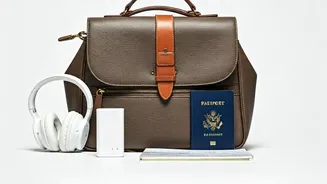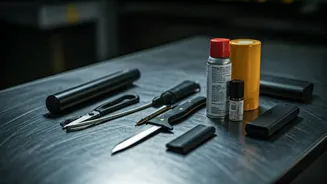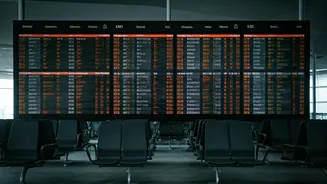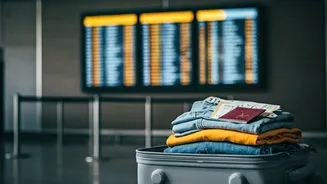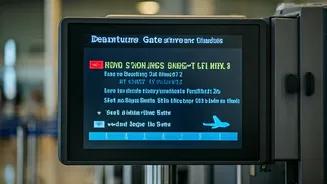Aviation Regulations Overview
Navigating air travel involves more than just packing your bags; it necessitates an understanding of specific rules designed for passenger safety. These
regulations cover a wide array of items, from the obvious like weapons to less apparent objects that could pose risks. Airport security, employing advanced technologies, carefully examines every piece of luggage. It is crucial to be well-informed about the prohibited items that could trigger security alerts or even result in the confiscation of your belongings. Familiarizing yourself with these guidelines beforehand can help you avoid potential delays and ensure you have a stress-free travel experience. These standards are there to ensure safety and prevent potential hazards, guaranteeing a secure environment for all travelers. Therefore, knowing these rules is key to a smooth journey.
Sharp Objects Concerns
Sharp objects like scissors, knives, and razors often land on the prohibited list for carry-on luggage due to their potential to cause harm. While small, rounded-tip scissors might be permitted, the safest approach is to place all sharp items in your checked baggage. This precaution minimizes the risk of accidental injury to passengers or crew. Security officials scrutinize such items carefully, and if a prohibited item is found in your carry-on, it could lead to delays as they assess the situation. Always err on the side of caution when it comes to sharp objects. For a hassle-free boarding process, it's best to pack these items securely in your checked luggage where they are less likely to cause concern or inconvenience during security checks. This avoids delays and promotes a safer travel environment for everyone.
Liquid Restrictions Reminder
A fundamental rule in air travel is the limit on liquids, aerosols, gels, creams, and pastes, often known as the '3-1-1 rule.' This mandates that any liquids carried in your carry-on be in containers no larger than 3.4 ounces (100 milliliters) and fit inside a single, clear, quart-sized zip-top bag. This applies to various items, including cosmetics, toiletries, and even food items like yogurt or peanut butter. The purpose of this measure is to enhance security by allowing screeners to easily inspect the contents for potential threats. Failing to adhere to this rule can lead to items being discarded at the security checkpoint or significant delays as your luggage undergoes additional screening. Pack accordingly, considering the size and packaging of your liquid items, to expedite your journey and avoid unnecessary hassles. Consider purchasing travel-sized containers or transferring larger quantities into approved sizes.
Battery-Powered Device Issues
Many electronic devices now rely on lithium-ion batteries, which, although convenient, require careful handling when flying. Power banks, laptops, tablets, and e-readers are among the common devices that pose potential risks. Airlines and aviation authorities regulate these devices due to the risk of overheating or catching fire. Regulations typically restrict the capacity of these batteries, often dictating that batteries over a certain wattage must be carried in checked baggage. Always ensure that the devices are fully charged prior to your flight to avoid having to use them during the flight. It’s also wise to turn off these devices or place them in airplane mode to minimize battery usage. Check your specific airline's guidelines, as they can vary. Proper precautions regarding battery-powered devices contribute to the overall safety of the flight, ensuring a smooth and safe experience for everyone.
Weapons and Replicas
Possessing any item that could be considered a weapon, including real firearms, knives, and even replicas, is strictly prohibited in carry-on luggage. This also encompasses any object that might be construed as a weapon, such as certain tools or sporting equipment. Security officials meticulously search for such items, and discovering one will result in immediate consequences, ranging from confiscation to potential legal charges. It’s essential to be extremely cautious regarding the objects you pack. Always familiarize yourself with the regulations of the airline you're flying with and the destination country's regulations. If you’re unsure, always err on the side of caution and check with the airline or airport security. Doing this will ensure you avoid any potential travel complications and maintain a safe environment for all passengers and crew members.
Flammable Materials Danger
Flammable materials, including lighter fluid, matches, and any flammable sprays, are strictly prohibited in carry-on luggage due to their inherent fire risk. These substances can ignite easily under various conditions, posing a significant hazard in an enclosed aircraft environment. Security screening processes meticulously examine for such items, and the discovery of any flammable materials will lead to immediate actions, including confiscation and potentially legal repercussions. Avoid bringing any flammable substances into the cabin. It’s critical to understand and follow airline and airport regulations regarding these items to ensure passenger safety. Before packing, carefully review the contents of your luggage to ensure that you are not carrying any potentially hazardous materials. This attention to detail will help ensure a safe flight.
Food Items Considerations
While many food items are allowed, some specific types can cause issues during security checks. Anything that resembles a liquid, like jams, yogurt, or soups, will be subject to the liquid restrictions, meaning they must be in containers no larger than 3.4 ounces and packed inside a clear, quart-sized bag. Moreover, foods that have a strong smell or could be considered disruptive, such as durian, may be restricted by the airline. To avoid any problems, pack food items thoughtfully and be mindful of their size and characteristics. Always check the airline's rules regarding food items, particularly if you are traveling internationally, because customs regulations also come into play. Clear labeling and proper packaging can help to avoid potential confusion during security and ensure a smooth boarding process.
Contraband and Illicit Items
The obvious category of items to avoid in your carry-on luggage comprises any items classified as contraband or illegal by law. This includes controlled substances, restricted chemicals, and any object that is deemed unlawful in the destination country. Possessing such items can result in severe legal consequences, including fines, detention, or even prosecution. Always familiarize yourself with the laws of the countries you are visiting, as they can differ significantly from your home country's laws. Security checks will rigorously screen for any illegal substances, and any discovery of prohibited items will lead to serious consequences. Before packing your luggage, carefully review the contents to ensure you are compliant with all applicable laws and regulations. If in doubt about an item, it's always best to leave it behind to ensure you have a safe and legal journey.
